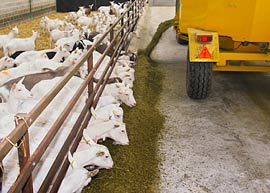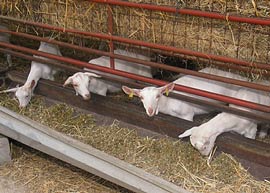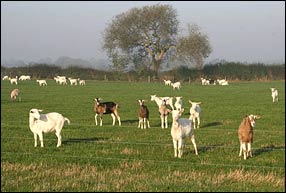Feeding is a critical part of the process of producing high quality goats’ milk.
The most commonly used feeding system is to feed a complete diet using a feeder mixer wagon.
Most diets use maize silage as the predominant ingredient with grass silage, red clover silage, sugar beet and protein crops such as rape seed meal or soya bean meal also being included. The composition of the diet can be varied on a daily basis if necessary and differing levels of energy and protein can be fed to different groups of goats depending on stage of lactation or pregnancy.
Some herds graze their goats, but it is more common to zero graze milking goats, housing them all year round, to prevent intestinal parasite infections and the need for treatment which involves withholding milk for human consumption. Grazing systems can be effective where sufficient grazing is available for goats to be rotated around paddocks as part of a parasite control strategy.
Whatever strategy of feeding is used in a herd, the importance of long fibre in the diet cannot be over emphasised. Constant access to good quality hay or clean barley straw in addition to a silage or concentrate based diet is essential to the maintenance of healthy rumen function..
Clean, fresh water needs to be readily accessible to all goats, salt licks also need to be available for all goats.
British Goat Society

patron: HRH Princess Alexandra
established 1879
tel: 01322 611767
email: [email protected]


